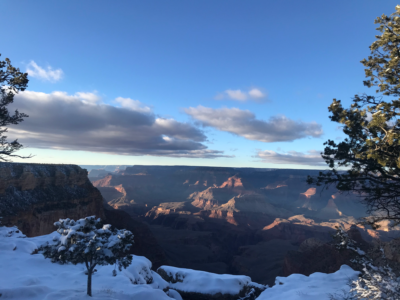 This past Saturday my cousin and I checked off a big to do item on our bucket list. After years of setbacks, cancelled flights, covid, and other planning errors, we finally ran (fast hiked) from the South Rim to the North Rim and back at the Grand Canyon in a single day, commonly referred to as a rim to rim to rim. This article will give a brief recap of the details of our 16 hour 43 mile run, and may have a follow up next week to expand more on the mental side of such a physically strenuous effort.
This past Saturday my cousin and I checked off a big to do item on our bucket list. After years of setbacks, cancelled flights, covid, and other planning errors, we finally ran (fast hiked) from the South Rim to the North Rim and back at the Grand Canyon in a single day, commonly referred to as a rim to rim to rim. This article will give a brief recap of the details of our 16 hour 43 mile run, and may have a follow up next week to expand more on the mental side of such a physically strenuous effort.
First, the details. Our day began at 3:45 AM at the trailhead to the South Kaibab Trail on the South Rim of the canyon. We were well prepared for the temperatures and the conditions. The temp at the time we started was somewhere around 10 degrees and there was 3-4 inches of snow and some ice on the trail. We started the run with spikes on our shoes but were able to remove them about a mile into the run. We descended altitude so quickly that we saw a pretty quick rise in the temperature, so the snow and ice was no factor for much of the beginning of our adventure. Our planned route was South Kaibab trail, past the river, meet up with North Kaibab trail to the North Rim then return the same direction. The route was the only plan we made that we were able to keep!
The issue we were completely unprepared for was the condition of the trail. The South Kaibab trail is a heavily trafficked path used by both hikers and mule trains delivering people and supplies into the canyon. Much of the trail was rutted out and given the lack of ambient light, we decided it was unsafe to run until the sun came up. We had headlamps and flashlights but this was not enough to adequately avoid some of the terrain. Not being able to run much in the first 7-8 miles likely cost us 1-2 hours on our overall time since we were banking on being able to lightly jog the downhill and flat sections of the route.
I’ve always heard that it’s always darkest before the dawn, and the Grand Canyon drove that point home. I’ve been to the canyon several times. I know what to expect when you get to the trailhead of the Kaibab trail. However, I have never seen the canyon at 4 AM. As we looked out over our route we were met with nothing but a pitch black abyss that offered as much mystery as it did danger. Above the canyon was the most spectacular showing of stars (and shooting stars every couple of minutes) which I have ever seen. I won’t attempt to describe it because I could never do it justice. This would be the last view of the day that I was able to actually enjoy.
Several miles into our trip down to the river we were hiking at a pretty quick pace averaging about 14 minutes per mile. Beyond a shadow of a doubt, speed hiking is harder than a light jog. The long strides and fast leg turnover takes a serious toll on your legs, especially downhill. While moving along at a great pace I encountered my first bit of bad luck as I hit a loose patch of gravel, lost my balance, slid down a step then caught myself by extending my left leg. I didn’t fall, but I hyperextended my left knee. The shock of it was quickly overcome once I realized I hadn’t significantly injured myself, but I knew that slight sprain/strain injury I had just developed was only going to be exacerbated over the course of the day. It hurt, but only slightly. After much discussion about turning back at that point, we ultimately decided to press on knowing full well that my knee was going to be a problem later on in the day. As we continued forward I had very little pain in my knee, but could tell there was something wrong. Keep that story in mind.
Crossing the river is a significant experience because it makes you think you are halfway to the North Rim. As it turns out, you are only about 1/3 of the way there. You are only 7 miles into the 21 mile journey to the North side. In the grand scheme of things you’re only actually 4/25 complete for the entire journey. After crossing the river we passed through Phantom Ranch campground and lodge in the basin of the canyon. After being greeted by a mule deer about 3 feet away from us, we stripped some layers, ate some food (we tried to eat 300-500 calories per hour), and carried on. It was about this time (7 AM) that we had enough light to ditch the head lamps and carry on by the light of day. This was the first “uh oh” moment. Upon leaving Phantom Ranch is when the realization hits you that the trip up the north rim and back down to phantom ranch is 28 miles. Yes, that is more than a marathon. After you’ve already done 7.5 miles. And after returning to the ranch you will still have a 7.5 mile climb to get back to the South Rim. This really is the commitment point. As they say in the Canyon, hiking/running down is optional, hiking out is mandatory. During the winter months there are no services at all on the North Rim. You are completely on your own. The only option is to get back to the South Rim. That was the moment we realized that each step away from the South Rim was borderline perilous. Especially with a bad knee.

Much of the run up the North Rim was pretty uneventful. This portion was pretty enjoyable for me because i have only gone about halfway up the North Kaibab trail prior to that day. The North Rim is a long gradual climb for about 9 miles, but at the 5 mile point things get very real as you all the sudden find yourself gasping for air and gaining hundreds of feet every switchback. That’s not to mention the snow. The snow was about ankle deep for the last 2-3 miles up the rim leading to my feet developing a slight case of frost nip before I was able to change socks.

If you’re at all familiar with endurance sports, you’ve likely heard of the “bonk.” The bonk is when you reach a point where you have depleted every ounce of energy available and each step forward feels near impossible. I was expecting to bonk, but not at mile 20. We were a couple miles from the top of the North Rim and quickly approaching our self imposed turnaround cut off of 12:00 when I looked at my cousin and said simply, “I’m in trouble. I’m bonking.” Remember what I said earlier about having to go back to the South Rim no matter what? I was having serious doubts about the safety of pressing further and being able to safely return. We weren’t completely sure of how far we had to go to reach Coconino overlook, which would be our North Rim turnaround landmark, and I was afraid we were looking at another hour of climbing before reaching that point. After 5 minutes of soul searching I decided I was ok to press and we kept going. This is when I entered what some refer to as the “pain cave.” I put my head down and focused only on controlling my breath, heart rate, and one foot in front of the other. During these times it’s essential to limit your focus only on the things you can control and just embrace the burning pain as part of the process. Learn to not only live with the pain, but honor it…..It’s part of the experience.
Never the less, we reached Coconino overlook, and after enjoying the view for a couple minutes and putting down a few hundred calories we were embarking on the second half of our journey during the return trip. About 1000 vertical feet down I was feeling good. Really good. Good enough to break into a run. We reached cottonwood campground, changed socks, scarfed down some more calories, and continued on. At this point, most of the return trip to phantom ranch is a long gradual down hill. Finally, we were able to run consistently. Ironic thing is that we started doing our most consistent running once we reached the magical 26.2 marathon mark. We made up a great deal of time running back 10-12 miles to phantom ranch before we both agreed that phantom ranch to the south rim would once again be a fast hike. The only downside of all this running was that it was downhill, and any runner will tell you that downhill running is harder on your body than uphill (though uphill is hard on the lungs and heart). Remember that knee I told you about? By the time we reached phantom ranch (35 total miles into our 42-43 mile day) my left knee had swollen to the size of a softball. This will make for an interesting return trip.
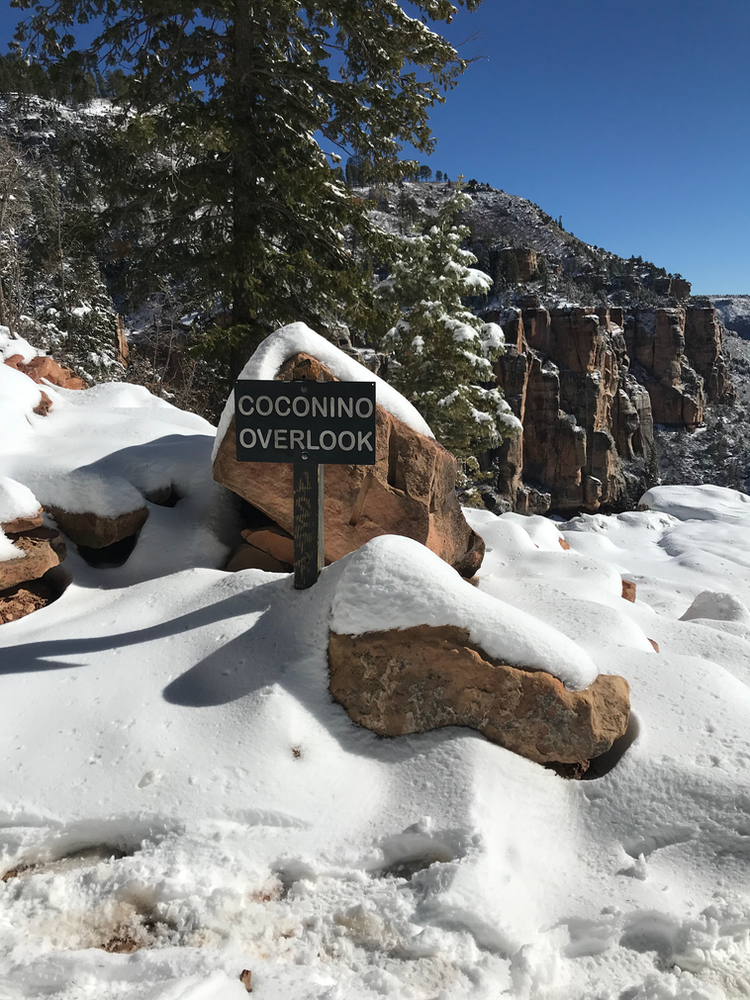
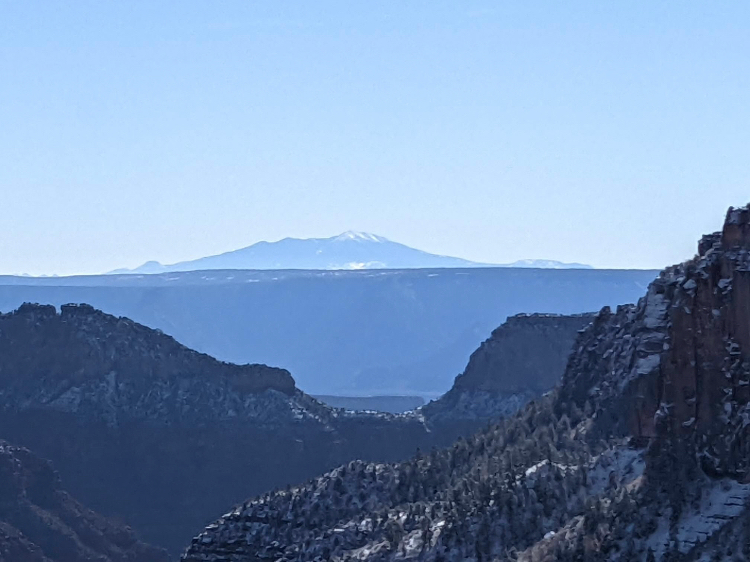
With the sun rapidly dropping below the horizon, temperatures falling, and my knee resembling a water balloon, we had no other choice but to begin our long climb out. So, we took some pictures of the bridge before we crossed the river for the second time that day and once again, pressed on.

Aside from the joy of watching a sunset and getting to see a duo of mountain goats playing alongside vertical cliffs, the remainder of the adventure was brutal. It was time to re-enter the pain cave. For the next 7ish miles our only focus was digging our pole into the ground and placing one foot in front of the other. Step after agonizing step was taken with the same amount of care and concentration as walking over a living room floor full of legos. Which, by the way, with frost bit and possibly broken feet and some toenails on the verge of falling out, each step actually felt like stepping on legos. Just keep moving.
After sunset we were treated to a beautiful illumination from the moon and another star show, but were also greeted by below freezing temperatures. If you’ve been to the point of absolute physical exhaustion, you will likely recall that your body is no longer able to regulate it’s own temperature. Like I said before, we were well prepared for the temps but that only helped so much. Uncontrollable shivering is the norm at this point. Just keep moving.
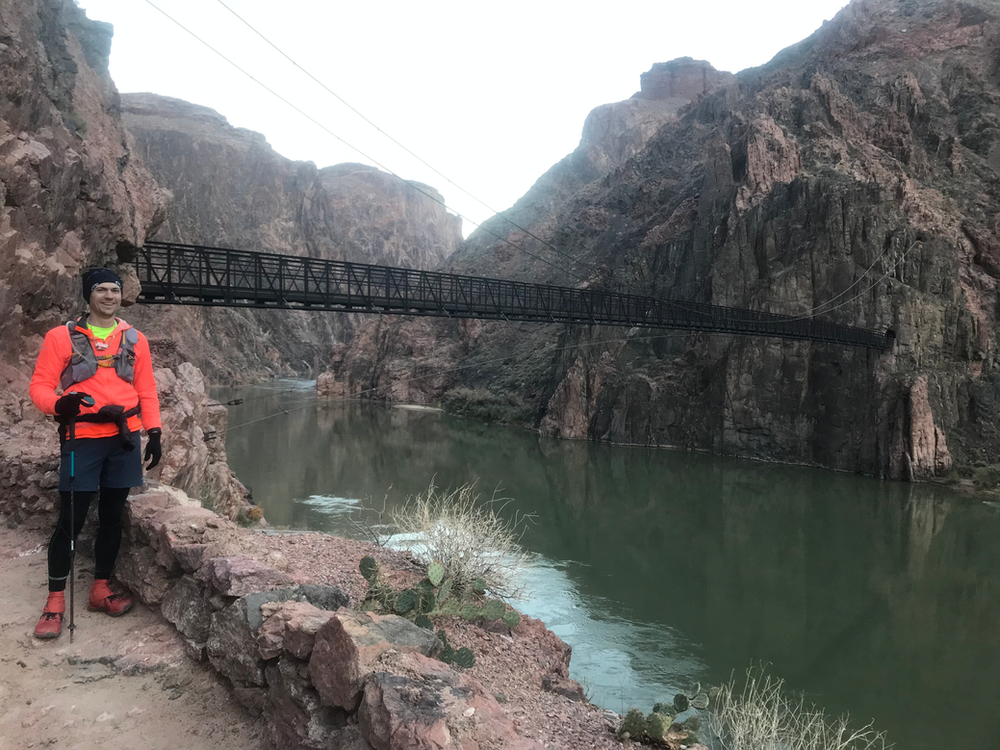
Up to this point, I have only really talked about my experience and not my cousin’s. Truth is, he was hurting as much as I was, but he is a true ultra runner and recently competed in a 100 mile race in October, so he had a level of familiarity with this level of “discomfort.” When I pressed him to compare the current day’s experience to the 100 miler, he said they were about the same level of effort despite the difference in distance.
Now that the sun had dropped below the horizon the only thing we could set our minds on was moving forward up the south rim. By this point fatigue had set in to the point where we could no longer control our heart rate and breathing. I was now hitting my second “bonk” of the day, but this time around I couldn’t just put down more calories to overcome it. My stomach was making it very clear to me that I could no longer eat anything else. I had eaten another 700 calories prior to going up the south side, and that would have to suffice because the only thing I could hold down was water.
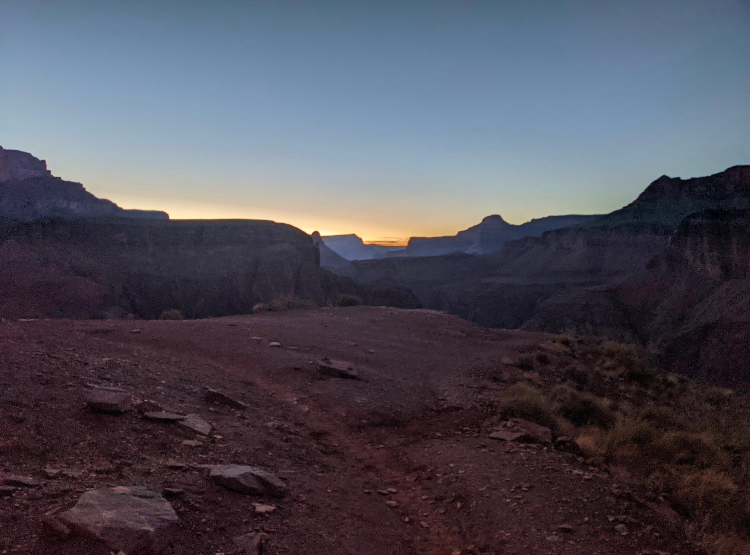
Every step was agonizing. We would make our way across a switchback then rest for a minute at the turn before going up another switchback. Our focus was placed solely on controlling our heart rate and breathing. Our normal wise cracking and joking banter was done by now. Talking wasted too much energy, but was also the only thing keeping me somewhat sane and distracted. That’s quite the tradeoff to have to decide whether or not we can continue chatting while dealing with our situation, or save the breath. Didn’t really matter, however, because I could barely form words at that point.
Finally, after another 3 hours or so of constant vertical climb we spotted a rock wall and a stretch of concrete that told us we had reached the trail head. We made it. After years of planning, attempts, cancelled flights, and interfering Air Force commitments (my cousin is also in the Air Force/Space Force), we were finally able to complete this challenge that had enticed us for so long. With better weather could we have completed it faster? Yeah, probably (the fastest recorded time for the route we did was just under 6 hours set by ultra running phenom Jim Walmsley). But I don’t think I will ever find out if I could go faster. If I ever return for another trip below the canyon rim it will be a multiple day hike or maybe a mule ride. I checked this one off the list and I’m good with that.
As I write this article, I am about 36 hours removed from the completion of our run/fast hike. I likely will not recover from the effort for at least a week or so. Sleep is still a challenge and my feet are constantly reminding me of what I had done. Try as I might I don’t think I can explain the emotion of having completed this challenge.
All told we went over 43 miles in just over 16 hours and completed close to 12,000 feet of vertical gain (and equal elevation loss) with our climbs averaging over 500 feet of vertical gain per mile. Frankly, what we did was stupid and arguably irresponsible. We were both fit enough to accomplish the task, but that amount of physical activity is not necessarily good for you and doesn’t exactly add years to your life, which begs the question, “why?”

The short answer is “because I can, and someday I won’t be able to anymore.” That’s really the only answer I can give. Accomplishing something incredibly challenging like this that pushes you to an absolute level of exhaustion teaches you more about yourself than any self help book, counseling session, or leadership book. In 16 hours I experienced a lifetime’s worth of emotions, challenges, pain, euphoria, difficult decisions, danger, euphoria again, sinking depression (like finding out our next waypoint is still 2 miles away when you thought it was a few hundred yards), and then ultimately the satisfaction that comes with completing something you set out to do years ago. Completing an unsupported run like this one that has no aid stations, no rescue vehicles, and no crowd to cheer you on teaches you that sometimes the only thing you can do is continue moving forward. Not to sound dramatic, but quitting equals certain death. It gets cold in that canyon. Getting out under your own power is the only answer. If you don’t get out they will be sending a search party looking for you and nothing about that sounds desirable. Just keep moving.
Hard effort is relative, but I believe hard effort is necessary in today’s world. Accomplishing hard physical tasks will change your mindset more than anything else. The mind and physical body can not be separated. In today’s instacart, instagram, door dash world, physical challenge is a missing piece for most Americans. We don’t even have to drive to the grocery store anymore. Interpersonal interaction is as simple as clicking “like” on a facebook post. We have lost connection to each other, our physical bodies, nature, and ultimately ourselves. The result of this super easy life we lead comes in the form of not only physical health challenges, but also mental health challenges. After all, how many more studies have to be done showing strong links between physical activity and mental state? Every now and again we need to embrace a physical challenge that makes us uncomfortable and maybe even a little scared. For you, that probably isn’t traveling to Arizona to run across the Grand Canyon and back. Maybe it is training for and completing a 5K. Maybe it’s developing the ability to do pushups and pull ups. Maybe it’s accomplishing 10,000 steps every day. It doesn’t have to be extreme to be effective, it just has to get you moving and provide a little physical stress. Set a physical goal and accomplish it for no reason other than you are worth it.
If you are still reading, thank you for obliging me and reading my ramblings. I hope you enjoyed the article and some of the pics in here too. I look forward to seeing you in the office and I’ll be more than happy to talk about the experience next time I see you!

